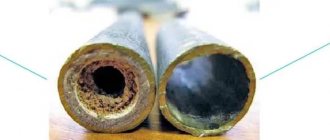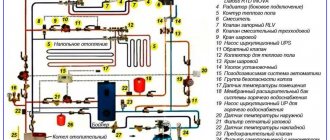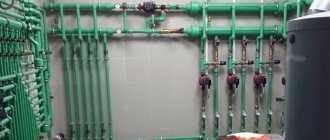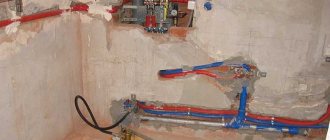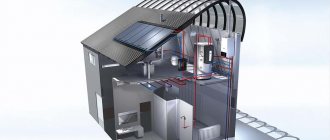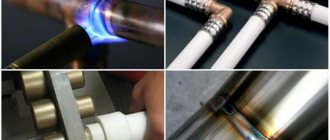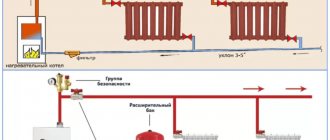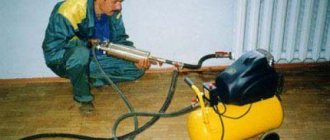In any heating systems used for heating individual cottages and dachas, mud deposits accumulate over time, interfering with their functioning. To bring them to a state of operation with the best efficiency, flushing the heating system in a private house is used.
Typically, many homeowners perform these procedures with their own hands without calling specialists. In this case, they should know the various options and technology for carrying out the work, and the equipment used.
Rice. 1 Main components and diagram of a domestic heating system for a private house
Causes of blockages in domestic heating systems
Typically, ordinary distilled water or antifreeze circulates through the heating circuit, which carries dirt. The immediate appearance of mud deposits can be caused by the following reasons:
- In some heating systems of a closed or open type, replenishment and replenishment of the coolant is carried out by supplying water from the water main. Since ordinary water contains salts of various metals, when it is heated, scale forms, which reduces the efficiency of the entire system.
- The popular antifreezes used, ethylene glycol and propylene glycol, have a limited service life. When it is exceeded, the liquid decomposes with the formation of solid sedimentary fractions, leading to unpleasant consequences.
- If the operating temperature of antifreeze is exceeded in the event of emergency situations associated with equipment malfunction, the heating fluid may lose its initial physical and chemical parameters with the formation of an insoluble precipitate.
- The use of low-quality homemade antifreeze leads to the fact that they disintegrate with the formation of solid deposits.
- A large number of heating boilers contain heating elements made of steel and cast iron. Since these metals are subject to corrosive decomposition, the resulting rust leads to a decrease in the performance of the entire heating system of the house.
- Some heating circuits use galvanized or regular steel piping. The pipe material deteriorates over time, and the rust formed as a result of these processes leads to a decrease in the flow area of the channel and, accordingly, a decrease in the efficiency of the entire system.
- Sometimes colonies of bacteria form in a heating system without drained coolant or when it operates at low temperatures. Their reproduction leads to blockages and destruction of metals by waste products.
Rice. 2 Examples of the location of blockages in radiators and their type
Recommendations for selection
Before buying a filter for a gas boiler, you should consult with a specialist who will recommend a suitable device and give recommendations.
General recommendations for selection:
- If you plan to use a gas boiler frequently, it is better to give preference to an electromagnetic device: it will not allow scale to accumulate on parts, and will also work for a long time without additional maintenance.
But it should be remembered that you will have to constantly change the filler and the service life of these filters is shorter compared to electromagnetic ones.
- When choosing a device, you need to immediately decide where to install it. Sometimes installation requires a large space, which is not always possible.
- Be sure to make sure you have a warranty card. Good manufacturers of such devices never sell their product without providing a guarantee for it.
- It is preferable to purchase devices from well-known brands, since such products are more difficult to counterfeit. Often, unscrupulous sellers sell counterfeits under the guise of a well-known brand at a very low cost, so you should also pay attention to differences in prices for filters from the same manufacturer.
- If the tap water is hard, then in order to better protect the gas boiler, it is recommended to buy two filters at once , focused on different degrees of water purification.
- To simultaneously soften the liquid and protect the internal parts of the boiler from possible damage, it is better to use devices that soften water and have the ability to create a protective film on the heating elements.
Signs that a flush is needed
The following factors may indicate the need for flushing:
- Filters are dirty. A properly assembled heating circuit must contain coarse filters in a transparent flask. In this case, intense contamination of the cartridge indicates the need to flush the heating circuit.
- A signal about the need for flushing can be the low temperature of radiators, heated floor circuits, or their prolonged heating.
- Increased electricity consumption by a heating boiler for heating premises in comparison with the previous period indicates the formation of a layer of scale on its heat exchanger.
Coarse filter
The filter is installed when connecting the heating system to the central water supply. It is a flask with a filter element inside. The connection can be flanged or coupling, depending on the diameter of the water supply pipes. Necessary for filtering large contaminants. Effectively retains dirt, sand, large abrasive impurities. It will reliably protect the heating system from large elements, but will let small ones through. It is also not capable of chemical cleaning or water softening. He cannot purify the water to the desired state on his own. Doesn't take up much space. The coarse filter is the first line of defense for your home's water supply.
DIY washing equipment
A properly designed heating system should have a threaded pipe with a ball valve at the very bottom of the pipeline to drain the coolant. Usually, heating fluid is poured through it, screwing a flexible liner to the fitting.
For supply, use any plastic containers, hoses and an electric water pump. Typically, inexpensive vibration pumps are used as pumping equipment. In their absence, you can use pumping stations or surface circulation electric pumps, their downhole submersible analogues.
Many specialists use special pressure testing machines to fill the heating fluid circuit. There are a number of other options for supplying liquid to the pipeline using hand pumps.
Sometimes situations arise when the passage channel of the heating circuit is completely clogged. In this case, they call specialists who carry out cleaning using special equipment - compressors, pneumatic guns, high-pressure units.
Rice. 3 Pumping units with tanks for professional hydrochemical washing
Related article:
What should be the pressure in the heating system, how to increase or decrease it . On our website there is a separate article describing the pressure standards in the heating system in a private house and in a city apartment, as well as how to increase or decrease it. Read it, it might be interesting and relevant.
Design Features
Mud traps for heating systems externally represent a pipeline expansion unit with water filtration using a special mesh and changing its direction. Under the mesh, medium and large suspended particles are cut off, precipitated, and subsequently accumulated.
Dirt traps must be installed in such a way that they provide easy access for cleaning and inspection. In most cases, they are installed at TP control units and building inputs.
Flushing the heating system in a private home - options
When choosing a system cleaning option, first of all pay attention to the type of contamination. If cleaning the house is done with chemical reagents, the materials used to make the pipeline and radiators are important.
Hot water
Typically, this method is used to clean the heating circuit when replacing antifreeze that has expired - ethylene glycol, propylene glycol, glycerin.
In this case, the liquid is drained, the filters are washed, and then water is pumped into the circuit under a working pressure of 1 - 1.5 bar. Next, turn on the boiler to the operating or maximum heating temperature, and force the water to move along the circuit using an electric circulation pump.
After some time, the water is drained, after which the circuit is filled with non-freezing liquid.
Rice. 4 Types of flushing fluids
Chemical reagents
One of the most widely used methods for flushing the heating system in a private home is the use of chemicals. Usually they are an acid or alkali dissolved in ordinary water.
It is worth noting that the main sources of pollution are metal corrosion products. Since acids work best with rust, they are used much more often for flushing heating systems than aggressive alkalis. The recommended content of the most commonly used hydrochloric or sulfuric acids in washing solutions is from 3 to 10%.
Universal filter mesh
The simplest mesh filter for heating. It consists of a body (metal) and a cylindrical mesh located inside the flask. The housing is closed with a plug or tap, depending on the type of filter. Connection system - flange. There are washable and non-washable filters. Non-flush ones must be replaced at the end of their service life. The washers last a long time thanks to cleaning. It is necessary to stop the water circulation, dismantle the cover, remove and wash the mesh, and install it. In addition to its relatively low price, the mesh is attractive due to its simple design, easy maintenance and cheap components. This filter is installed in front of the fine cleaning system. This is the penultimate level of protection. Serves to purify water from scale or solid inclusions. Pipe fittings or pumps damaged by scale will cost tens of times more than a cheap filter. The filter does not take up much space.
How to prevent contamination of your home heating system
To avoid frequent contamination, blockages of household heating systems and associated cleanings, it is useful to pay attention to the following expert advice:
- The main enemy of steel radiator, bimetallic (they have a steel pipe manifold inside) heat exchangers and heating elements of boilers is oxygen dissolved in water. Pipelines made of any metals do not allow it to pass through, but popular polypropylene is not a barrier for it. Therefore, it is unacceptable to use polypropylene or fiberglass-reinforced heating pipes in the system with any type of steel components. The pipeline must be made of metal-plastic or polypropylene reinforced with aluminum. Cross-linked or heat-resistant polyethylene used in heated floors must have an oxygen-impermeable EVOH shell (copolymer of ethylene and vinyl alcohol).
- Tap water entering the heating boiler feed system must be cleaned of metal salts - when the coolant is heated, they form a deposit in the form of scale. To do this, it is advisable to install a filter with ion exchange resins in the path of the recharge flow.
- Any thermal carrier loses its chemical activity over time due to a decrease in the oxygen concentration in its environment. Therefore, replacing it too frequently is not recommended. For example, ordinary water does not lose its properties and can circulate in the circuit for an indefinitely long period of time, being cleaned using self-washing filters with polypropylene cartridges.
Rice. 12 Selection table for some brands of washing reagents
The simplest and most effective way to independently flush individual heating systems is to use commercially produced chemical solutions. The cleaning procedure can be carried out both with individual elements (radiators, boilers) and with a closed heating circuit if the materials of all components match.
The most basic circulation pump breakdowns: and how to fix them
The pump makes a loud noise and hardly pumps
If, after a long period of inactivity, when turning off the device, a hum is heard, this means that the shaft has oxidized. To return the equipment to serviceability:
- Turn off the power to the heating equipment;
- Remove the liquid from it;
- Remove the engine;
- Then rotate the rotor using any possible method.
Less commonly, the cause may be a foreign object that is stuck inside the device. To remove it, you also need to turn off the power, remove the water, and remove the housing fixing screws. To avoid such problems, it is worth installing a mesh filter.
Source of the article: https://makipa.ru/stati/cirkulyacionnye-nasosy/kak-pochistit-cirkulyacionnyj-nasos-otopleniya-kak-rabotaet-konstrukciya/
Conclusion and useful videos
Powerflushing is most often used to flush heating systems. There are many companies that specialize in providing this service, but you can also rent equipment and do the flushing yourself. Since the quality of washing depends on the equipment, you need to carefully study the features of using the washing machine. This equipment usually comes with instructions.
Follow the manufacturer's instructions for connecting the washer. Note that flushing is usually more effective at higher temperatures. Some flushing systems allow the boiler to run simultaneously, others may be equipped with their own water heating facilities.
How is pipe cleaning with citric acid carried out and how effective?
The most effective ways to remove blockages in sewer pipes are mechanical and hydrodynamic cleaning. But to carry out such procedures, you often need to call a specialist. If only because of the lack of the necessary tools at home. Therefore, enterprising people often use folk remedies to clean pipes with citric acid.
This solution cannot be called extremely effective, but there is some benefit from it. Therefore, today we will tell you how to properly use citric acid to clean pipes. At the same time, let's talk about specific results that can be achieved using the mentioned cleaning method.
Specifications
| Mud collectors for heating systems | |||||||||
| Conditional diameter, DN | Weight | Conditional pressure | D.H. | DH1 | DH2 | H | H1 | h | L |
| 32 mm | 201.9 kg | 1.6 MPa | 159 mm | 32 mm | 32 mm | 1120 mm | 1168 mm | 700 mm | 850 mm |
| 40 mm | 16.3 kg | 1.6 MPa | 159 mm | 40 mm | 45 mm | 360 mm | 406 mm | 260 mm | 345 mm |
| 50 mm | 19.4 kg | 1.6 MPa | 159 mm | 57 mm | 57 mm | 410 mm | 456 mm | 290 mm | 365 mm |
| 65 mm | 29.4 kg | 1.6 MPa | 219 mm | 76 mm | 89 mm | 490 mm | 534 mm | 340 mm | 425 mm |
| 80 mm | 33.5 kg | 1.6 MPa | 219 mm | 89 mm | 108 mm | 525 mm | 569 mm | 375 mm | 425 mm |
| 100 mm | 62.2 kg | 1.6 MPa | 325 mm | 108 mm | 133 mm | 620 mm | 662 mm | 450 mm | 525 mm |
| 125 mm | 70.4 kg | 1.6 MPa | 325 mm | 133 mm | 159 mm | 690 mm | 732 mm | 470 mm | 525 mm |
| 150 mm | 118 kg | 1.6 MPa | 426 mm | 159 mm | 194 mm | 875 mm | 928 mm | 550 mm | 650 mm |
| 200 mm | 266.7 kg | 1.6 MPa | 530 mm | 219 mm | 273 mm | 1105 mm | 1163 mm | 700 mm | 850 mm |
| 250 mm | 266.7 kg | 1.6 MPa | 530 mm | 219 mm | 273 mm | 1105 mm | 1163 mm | 700 mm | 850 mm |
The nuances of using soda and citric acid for cleaning pipes
The effectiveness of the presented methods depends on two nuances. The first is the nature of the blockage. It was already mentioned above that cleaning pipes with citric acid allows you to soften various deposits formed as a result of household activities (we are talking about washing dishes and other household activities). But the method does not help with the formation of serious blockages. If solid objects or other poorly soluble substances get into the drain, you will have to order professional removal of blockages in Khabarovsk. Other options won't help here.
The second nuance is the density of clogging. The above methods are applicable when water is still flowing through the drain. If the clog is so dense that the water remains in the sink (that is, does not drain at all), cleaning with citric acid will be useless. The blockage will have to be removed mechanically. Chemistry does not help in such situations.
Source
